Author: lsa1wp1admin
How To Profit From The Short Squeeze Trading Stocks
On November 8th, 2016, The US Presidential Elections were held. Early the next day, it was announced that Donald Trump was the winner. The following day, we saw a number of sectors trade significantly higher (and some lower), based on what investors trading stocks thought it would benefit/suffer under the new President-elect.
Clearly, an event of this magnitude is not a one-off. A shift in policy changes will have a longer term effect on certain stocks. With that said, some sectors that shined that following day were in the infrastructure, pharmaceutical, and banking space. It was believed that the President-elect would cause an inflationary effect to the markets.
One company that was believed to have benefited from this regime change was Top Ships Incorporated (TOPS), it closed the week up more than 30%, largely off the election results. However, the stock had some other interesting information pertaining to it. A large percentage of the shares were sold short and still not covered by those trading stocks.
In other words, investors borrowed shares from their broker to sell, in hopes that prices drop so they could buy them at a lower price and cover. In this case, we had a situation where the stock reacted to positive news, in addition; traders, who were short the stock, were causing more pressure because they were buying shares to cover their short.
These two factors can cause a stock price to rise dramatically.
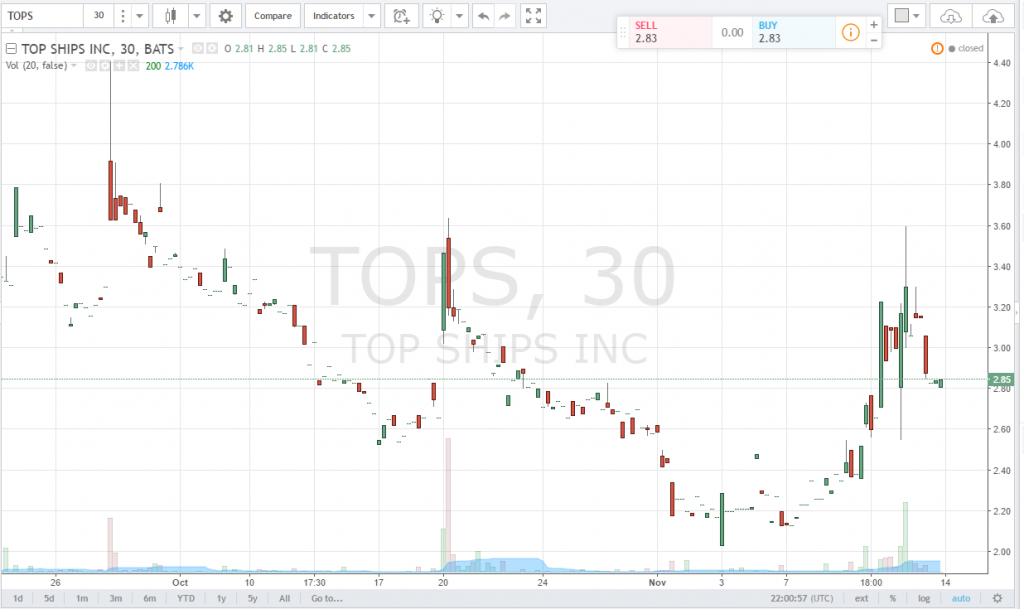
(chart: www.TradingView.com)
In this example, the stock price went from about two bucks to as high as $3.50 in just a matter of days.
If you’re a trader trading stocks, how can you use this information?
Well, let’s you traded mean reversion, and saw that the price of a stock normally trades in a $.50 range, and today for whatever reason it’s up $4. Without any other consideration, you decide to short and it ends up not working in your favor. Now, if you looked at the short interest of the stock, and noticed that it was relatively high, maybe you would have laid off on the short idea.
On the other hand, if you’re taking a long position, it might make more sense to size these trades smaller and play for a larger than normal move. A short interest stock combined with a positive catalyst can really send the stock price flying. Just being aware and be help in and of itself.
Is this information readily available when trading stocks?
The answer is yes, and for the most part, you can find a lot of it for free.
For example, if you hop on over to finviz.com, you can find important information like shares outstanding, shares float, and short float %.
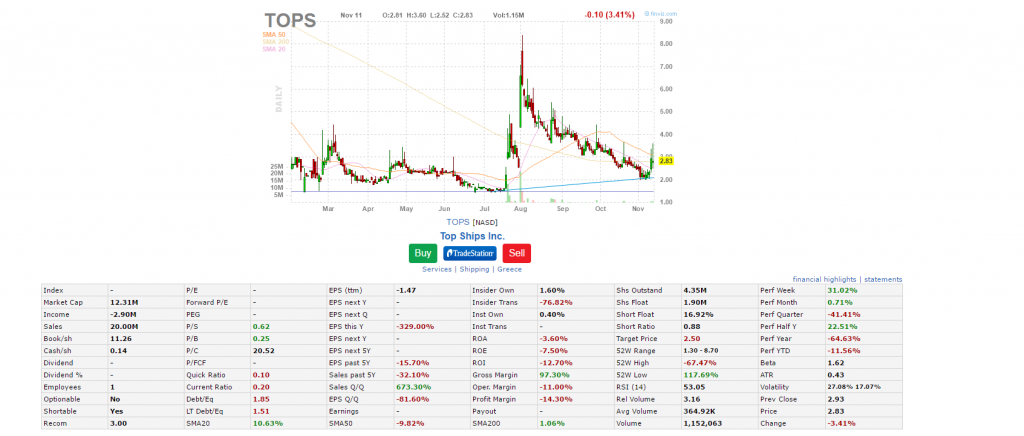
(source: finviz.com)
In this case, Top Ships had a short float ratio of 16.92%. However, it’s best to use more than one source. For example:
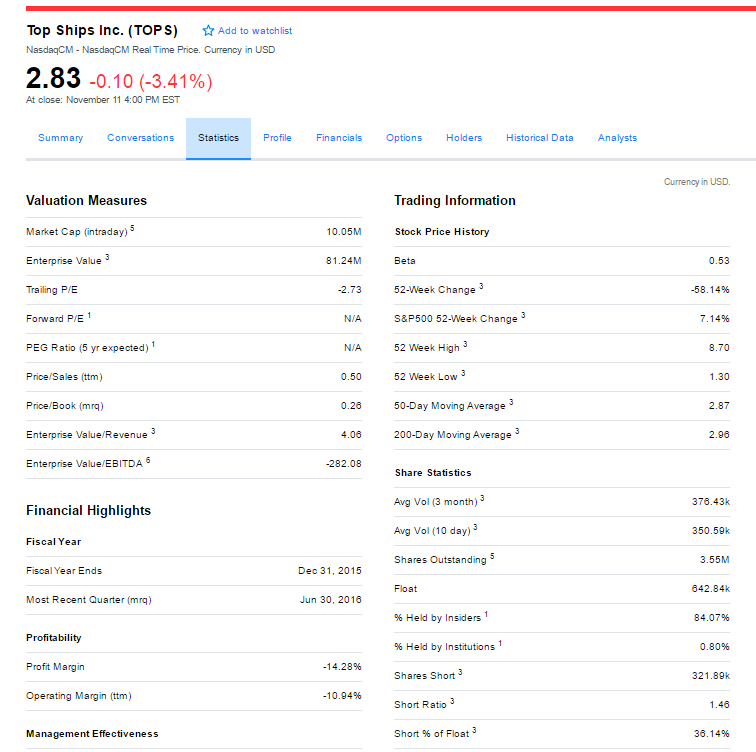
According to YAHOO! Finance, the short interest % on this company is 36.14%.
In a situation like this, where the two sources have a wide margin, check out another source.
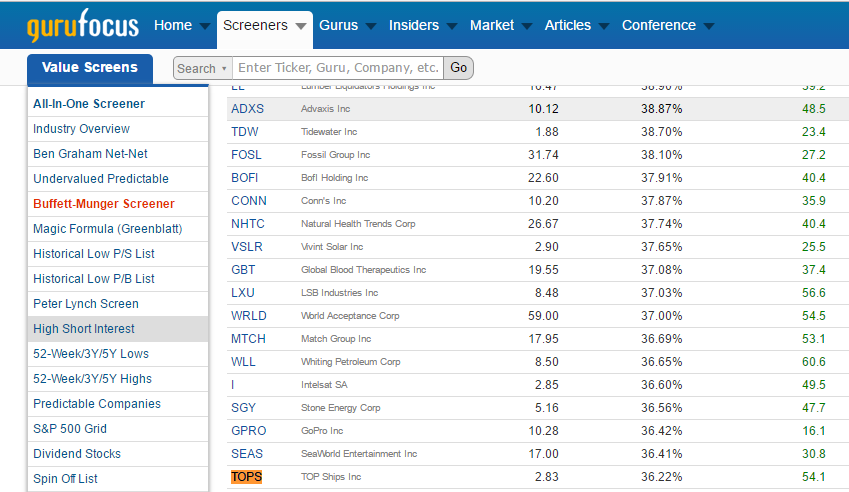
(source: gurufocus.com)
Being aware of a potential short squeeze can make you a lot of money or even save you a lot of money. The key is to be ready and prepared when trading stocks.
Dealing With Drawdowns When Trading Good Penny Stocks
Make no mistake about it, if you trade good penny stocks for a long enough period, expect to experience drawdowns. We all go through periods when things simply don’t go away. However, there is a difference between going through a trading slump and having losing trades.
With that said, let’s take a look at both, and how they affect our trading.
Now, depending on your strategy the number of drawdowns will vary. For example, if someone primarily only trades M&A deals, they might make money 95 out 100  trades. However, those five times that they are wrong can be costly. On the other hand, a discretionary trader might be right 40-60% of the time, and still manage to be very successful.
trades. However, those five times that they are wrong can be costly. On the other hand, a discretionary trader might be right 40-60% of the time, and still manage to be very successful.
A drawdown is simply a trade that is closed out for a realized loss. On a more macro level drawdowns can also be expressed in time periods. For example, one could say they drew down on the day, week, or month if they ended up realizing losses.
As mentioned, drawdowns are a part of the game. It’s important to understand that trading good penny stocks, in many ways, is a probability game…there are very few, if any certainties. The sooner you accept that, the better you’ll be.
You can learn just as much from your losing trades as you can from your winning trades. If you’re going through a losing period, take a step back and start scrutinizing your previous trades.
Ask yourself, “Are these mistakes are avoidable, or am I just a victim of variance?” Sometimes, we let our emotions interfere with our game plan, which ends up being a costly mistake. Of course, it can be more than that.
 For example, maybe there has been some shift in the market, and your strategy or thesis is no longer valid. Maybe a CEO resigns, or a new government law is comes into effect. A number of factors could come into play that would affect the dynamics of a company and its stock price.
For example, maybe there has been some shift in the market, and your strategy or thesis is no longer valid. Maybe a CEO resigns, or a new government law is comes into effect. A number of factors could come into play that would affect the dynamics of a company and its stock price.
Is the root of the problem in your mechanics? Analyze your execution and see if there is anything is different. Have you not adjusted your position sizing for the added volatility? Go through your process and see if there is anything different and worth noting.
Maybe you’re going through some personal changes. Ask yourself if you’re getting enough sleep, eating well, or dealing with stressful relationships. These are things we don’t think about that could affect our trading of good penny stocks, but they can…therefore, they’re worth addressing and trying to correct any of these problems.
For some, a series of losses could lead to confidence issues. It’s generally best to focus on improving your process. For example, instead of trading your normal tier size, scale down the number of shares down and just focus on executing your game plan.
Do this until your confidence comes back. What you don’t want to do is trade bigger in order to regain losses. You want to be trading your biggest when you’re most confident in your ideas, not when you’re having doubts and are unsure. That’s the secret to making the most of good penny stocks.
Top Penny Stocks Only Work If Traders Journal Their Trades
Now, there are just over 250 trading days in the year. Let’s say you’re an active trader and traded on average 3 top penny stocks per day. That adds up to 750 individual trades. Unless you have a photographic memory, you’ll probably only remember a handful of these trades, maybe your big winners or losers, or some interesting story that is tied into the trade. However, there is no way you’re going to remember all of them.
The time you spend in front of your screens can either be valuable or a waste, it’s really up to you. A valuable way to spend your time is by reviewing. It’s more or less  the same thing professional sports teams do when they study video footage of their opponents or previous game(s). They are examining to see if there is anything useful that they can find for their next encounter with the top penny stocks.
the same thing professional sports teams do when they study video footage of their opponents or previous game(s). They are examining to see if there is anything useful that they can find for their next encounter with the top penny stocks.
You can do the same thing by keeping a journal. Now, you don’t have to actually sit down and write in a notebook, if writing on your computer is easier, that works as well. The key is start recording information about your trades, thought process and tendencies.
If you’re unsure about what to journal here is some help:
Trade information: the time when the trades were made, whether you bought or sold, number of shares, holding period, and profit/loss.
Trade Thesis: In this section you would write about why you got into the trade and explain your edge in the trade.
For example, let’s say the stock price of a company was up 10% on a rumor that it might seek to put the company for sale. However, an hour later a company spokesperson comes out and denies the rumor. Some traders might start shorting  the stock off that headline. Their thesis is that the stock price rose on a belief that turned out to be false and because of that the stock should sell off.
the stock off that headline. Their thesis is that the stock price rose on a belief that turned out to be false and because of that the stock should sell off.
Well Being: In this part you want to write down about how you felt going into the trading day. For example, did you feel tired/refreshed, were you distracted/focused, did you start your day early/late/on time. Those are just some things worth considering. Some traders trade very poorly if they are hungover, while others don’t trade well without their coffee and breakfast. Find out what works for you and what doesn’t, and focus on winning with the top penny stocks.
Execution: Before every trade you should have your risk/reward mapped out. For example, I’m going to get in at this price and out here if i am wrong.
Once you know what your execution strategy is, then compare it to how you actually traded your plan. For example, let’s say you wanted to exit your long if the stock price dropped to $10, but for whatever reason you got out at $10.05.
Why?
It’s worth trying to answer why you were able or unable to follow through on the trading plan.
There is a lot more that you can include in your journal, these were just some ideas for you. The most important thing to do is journal, study and strive to improve trading the top penny stocks.
Should Day Traders Who Buy Penny Stocks Fear The Tick Size Experiment?
On October 3, 2016 the tick size pilot program was introduced into the market. It’s the regulators attempt to add liquidity to small cap stocks. The program consists of a control group and three test groups, there are 400 stocks per test group. Should day traders who buy penny stocks worry?
 The control group trades regular. On the other hand, the first test group will be quoted in five cent increments. For example, instead of seeing a stock being quoted 5.01 by 5.02, you’ll see it quoted in five cent increments like 5.00 by 5.05.
The control group trades regular. On the other hand, the first test group will be quoted in five cent increments. For example, instead of seeing a stock being quoted 5.01 by 5.02, you’ll see it quoted in five cent increments like 5.00 by 5.05.
Now, the second group is also quoted in the same fashion as the first group. However, there are some exemptions. Moving on, the third group works in the same way as the second, but they have exemptions for big block trades. Not only that, but they are subject to the trade-at-rule, which means you have to trade what is displayed on the exchanges before trading and buy penny stocks on a dark pool.
So the idea by having stocks trade in five cent increments is that market makers will be incentivized to facilitate orders. However, there are fewer and fewer traditional market makers left. The majority of market making is done by HFT and prop firms. For example, we wouldn’t have as many flash crashes in individual stocks if we still had traditional market makers.
You want to hear something crazy?
The person who helped lead the charge for the tick size pilot program is a former reality tv star turned politician. That’s right, not someone with a finance background or an understanding of market structure. You might not remember this, but the stock market used to trade in fractions, we later moved on to our present market structure where stocks are quoted in penny increments. So this change is kind of like going backwards if you think about it as someone that may potentially buy penny stocks.
Another argument on why the tick size program makes sense is that it might lead to  more coverage by banks. The idea is if banks get involved with market making, then their research departments will also start covering the stock. Better research on the stocks should lead to greater interest from investors. In their perfect world that’s how the dominos will fall.
more coverage by banks. The idea is if banks get involved with market making, then their research departments will also start covering the stock. Better research on the stocks should lead to greater interest from investors. In their perfect world that’s how the dominos will fall.
Every trader looks at the bid-ask spreads and makes a decision on whether the stock is worth trading. For example, if the average volume is low, the bid-ask spread is wide, and the depth of book is thin, then a lot of traders will avoid trading a stock like that. Generally, penny wide spreads, high volume, and a ton of bids and offers stacked on the book, are what most traders that buy penny stocks are looking for.
Overall, this sounds like an awful idea. The goal of the program is to collect data and see if situations improve in these low cap names. With that said, the program is running for about 2 years, so it’s not permanent. We’ll see how it plays out, whether or not the theory works in the real market for traders that buy penny stocks.
How Much Do Need To Get Started In The Stock Market?

Imagine you wanted to learn how to play the piano, and were in the market to purchase one. Now, if you’re not familiar with how much they cost, the range is anywhere between a couple thousand dollars to upwards of several hundreds of thousand dollars.
Do you think if you got a really expensive one, it would help you play better?
Heck no. Unless you’re rich, it makes zero sense to go out and fork over a lot of dough for something like this. The reason being, you are just starting out, you don’t even know if you’ll stick to it, and most likely you’re just playing for yourself, not like you need something fancy because you’ll be recording or performing for large audiences.
In business, they teach entrepreneurs to keep expenses lean and show proof of concept before expanding an operation. You don’t want to get involved with long-term leases or anything else that will put you under capital restraints. Again, you don’t know if the business will thrive, no reason to add pressure early on.
To most people, this makes a lot of sense. However, when you transfer this concept into penny stock trading, some don’t get it. You see, for whatever reason, some people think like you need to have a lot of money to get started in the stock market. That’s simply not true. And it is certainly not true when it comes to good stocks to invest in.

Going back to our previous examples, what is a lot of money going to do for you? In the beginning, you’re learning the fundamentals, discovering who you are as a trader, making mistakes, and hopefully learning from them. In other words, it’s a process… and having a lot of money doesn’t give you a pass or allow you to skip that. Why anyone would think this is the case with day trading stocks is somehow puzzling.
In fact, it actually makes more sense to start off small. Most likely, you will make more mistakes early in your trading career than later. Better to make small mistakes than expensive ones. For those saving, to get X amount to start trading… stop putting it off. Again, why wait? You might find out trading is not for you and realize that you just wasted time.
You must first learn the process of trading, finding penny stocks, and discover which strategies are suitable for your personality type. In addition, you must learn the skills of position sizing and risk management. For the most part, this will require you collecting data from your trades and analyzing that. That requires screen time, it doesn’t matter if you are risking $100 or $10,000 on a trade.
Ultimately, if you stick with it, learn and develop an edge… a time will come when you want to scale up your trading operation. Until then, start off small and begin the journey. Don’t focus on getting rich…focus on learning the process first. And don’t limit yourself to otc stocks, explore large cap stocks, too.
Imagine, leaving your day job to play the piano for a world-class orchestra without having any experience. Sounds silly right? Well, take that concept and apply it to trading. There is a learning curve involved in trading, the idea that you can leave your job to trade is really unrealistic. Well, initially it is. If you get to a point where you develop a strategy that has edge, and you’ve built up a solid track record…then yes, it’s possible to trade full time. However, you just need to get your feet wet in the beginning. That’s why you shouldn’t overly concern yourself with how much money do you need to get started — that’s the key to excelling at penny stock trading.
If You Don’t Understand ATR Now, You’ll Hate Yourself Later
Ever have the right idea on a stock trade, but not give yourself enough room for it work? For example, you buy too many shares, the stock initially drops and forces you to cover, only to see it later rebound and move in the direction you were expecting. You had the right idea, but sized the trade poorly.
Now, this a problem that many traders deal with, even ones who have several years of experience under their belt. Crazy moves happen and we underestimate volatility sometimes. However, some traders are absolutely clueless on volatility and they miss out on good stocks to buy.
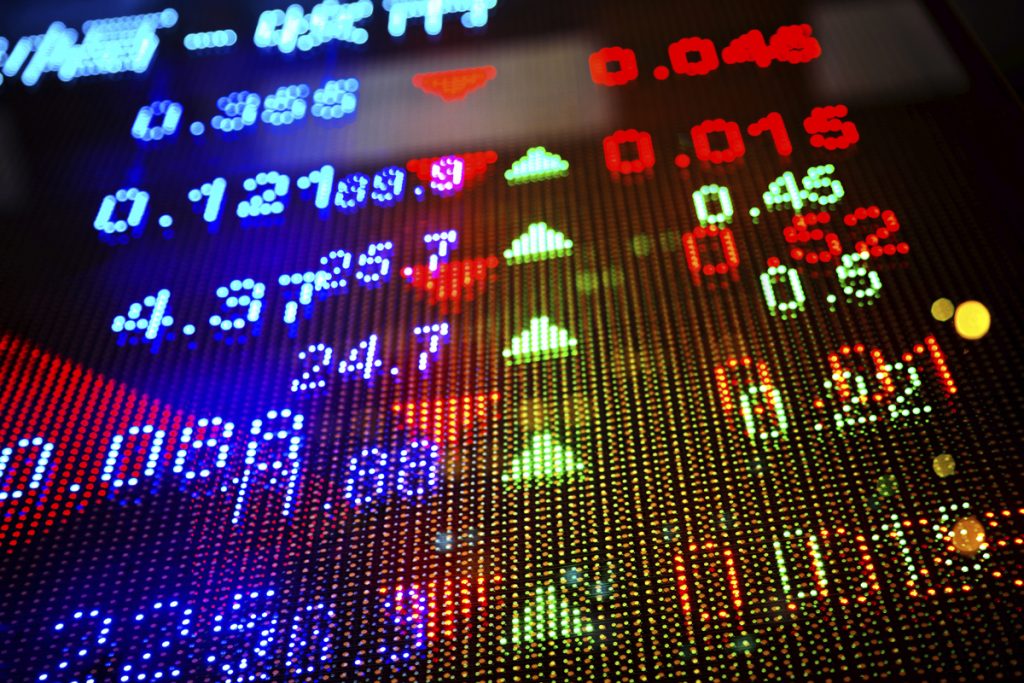
One tool that you could use to gauge volatility is Average True Range (ATR). In order to calculate ATR, the true range must first be discovered.
Now, the true range uses the most current period’s high and low range, not to mention, the previous close, if necessary. There are actually three calculations that need to be conducted and then later compared amongst each other.
In other words, the true range is the largest of these following:
The current period high minus the current period’s low. Example: $10 – $8 = $2
The absolute value of the current period’s high subtracted by the previous period’s close. Example: ($10 – $9)= $1
The absolute value of the current period’s low subtracted by the previous period’s close. Example: ($8- $9) = $1
true range=max[(high – low), absolute value(high – previous close), absolute value(low – previous close)
The ATR is a moving average, usually 14 periods, of the true ranges.
How can we use this to make better trading decisions on day trading stocks?
Well, it can help guide us on how to position size smarter. For example, if an ATR for a stock is $2, and we only want to risk $100 on the trade, buying 1000 shares is probably a horrible decision. If the stock moves just 10 cents you’ll be out of the trade based on your risk parameters. However, if the stock has an ATR of $2, a ten cent move is extremely minor.
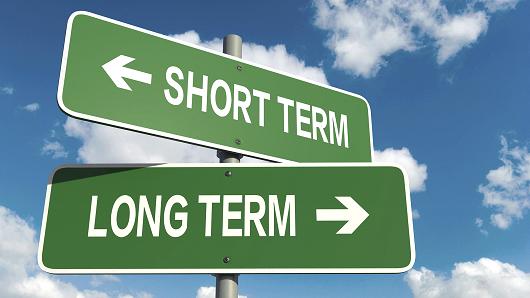
Of course, there are other elements to consider like support and resistance levels, along with recent highs and lows. But you can see how some traders can size a trade so poorly without considering volatility. Not only that, it could lead to churning their account, hopping in and out of trades and racking up trading fees.
You want to put yourself in a position to win, you’re not doing that if you are not including volatility in your trading decisions on the best stocks to watch.
What else?
You could also use ATR as a tool to enter/exit a trade. For example, let’s say the ATR for a stock is $1, and you notice there is no news in the name and it’s down $1.25. If the overall market is relatively normal, then playing for a bounce might make for a decent long. The idea is that on a normal day we can expect the stock to trade in this range and that it should mean revert at some point.
Again, this works best when stacked up with other criteria, but you can still see how it can be useful. On the flip side, if the stock price seems overextended, you might lay off and wait for a better entry given its move and ATR.
A lot of rookie traders get their position sizing wrong, along with entries and exits. Having a greater understanding of volatility and using a tool like ATR can help alleviate some of those easy to avoid trading mistakes and zero in on undervalued stocks.
